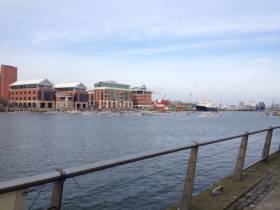| RESULTS by Time - Provisional - Masters handicap not applied |
| POSITION CREW |
| NUMBER Club Class Cox/Steerer Time % of winning |
| time Comments |
| 1 1 Portora Mens J18A 8+ R Farragher 14:35.4 100.00 |
| 2 7 QUBBC Mens Intermediate 8+ C Moorehead 14:37.4 100.23 |
| 3 15 Yarm School Mens Club 1 8+ O Cairns 15:08.7 103.81 |
| 4 14 Commercial Mens Club 1 8+ S Eustace 15:08.7 103.81 |
| 5 9 DUBC Mens Intermediate 8+ H Mulvaney 15:12.8 104.27 |
| 6 12 Portora Mens Senior 4X- B Rix 15:14.7 104.49 |
| 7 8 St Josephs Mens Intermediate 8+ C R Wanjau 15:14.7 104.49 |
| 8 2 Methodist A Mens J18A 8+ A Mawhinney 15:22.7 105.40 |
| 9 4 Commercial Mens J18A 8+ B McGuiness 15:28.6 106.08 |
| 10 29 Comm/OCBC/Neptune/BBC (d ) Mens Masters 8+ J Malloy 15:46.6 108.13 |
| 11 17 QUBBC Mens Club 1 8+ A Sloan 15:51.4 108.68 |
| 12 21 St Josephs A Mens J16 8+ E Finnegan 16:13.2 111.17 |
| 13 5 Neptune Mens J18A 8+ A Gillick 16:22.8 112.27 |
| 14 3 RBAI Mens J18A 8+ M Honan 15:22.7 105.40 |
| 15 10 Belfast RC / Lagan Mens Senior 4X- T McGivern 16:24.4 112.46 |
| 16 26 QUBLBC Womens Intermediate 8+ G Canham 16:32.1 113.33 |
| 17 25 DULBC Womens Senior 8+ N Williams 16:32.1 113.34 |
| 18 19 Neptune Mens Club 1 8+ P Dolan 16:36.0 113.78 |
| 19 18 DUBC B Mens Club 1 8+ A McCormick 16:44.4 114.74 |
| 20 16 DUBC A Mens Club 1 8+ C Keogh 16:47.2 115.06 |
| 21 22 Portora Mens J16 8+ B Corrigan 16:47.3 115.06 |
| 22 34 Bann Womens Senior 4X- A Odonovan 16:52.1 115.61 |
| 23 27 DULBC Womens Intermediate 8+ B Murphy 17:00.4 116.57 |
| 24 31 Belfast BC (f ) Mens Masters 8+ E Bell 17:00.6 116.59 |
| 25 40 Portora Womens J18A 8+ S Dolan 17:01.3 116.67 |
| 26 30 Belfast RC (f ) Mens Masters 8+ S Mairs 17:04.2 116.99 |
| 27 13 St Josephs Mens Senior 4X- F Vickers 17:07.0 117.31 |
| 28 24 Methodist Mens J16 8+ C Woods 17:12.9 117.99 |
| 29 28 Bann (d ) Mens Masters 8+ C Mitchell 17:13.3 118.04 |
| 30 11 Lagan Mens Senior 4X- P Cross 17:15.6 118.30 |
| 31 6 Methodist B Mens J18A 8+ D Morrow 17:25.5 119.43 |
| 32 20 DUBC C Mens Club 1 8+ J Davis 17:38.6 120.93 |
| 33 37 Commercial Womens Senior 4- K Curran 17:42.5 121.37 |
| 34 32 LVBC (f ) Mens Masters 8+ M Warnock 17:49.4 122.16 |
| 35 41 Commercial A Womens J18A 8+ S Carpenter 17:51.1 122.36 |
| 36 38 Methodist Womens J18A 8+ S McKeown 18:22.1 125.90 |
| 37 46 Belfast BC (e ) Womens Masters 8+ C Watters 18:28.4 126.62 |
| 38 45 Yarm School Womens Club 1 8+ J Dodds 18:31.6 126.98 |
| 39 36 QUBLBC Womens Senior 4- A Buck 18:32.0 127.03 |
| 40 43 DULBC A Womens Club 1 8+ C O'Donnell 18:34.1 127.26 |
| 41 35 Belfast RC Womens Senior 4X- L Taylor 18:50.0 129.09 |
| 42 49 Portora A Womens J16 8+ R Conway 18:56.0 129.77 |
| 43 42 DULBC B Womens Club 1 8+ S Oster 19:40.0 134.80 |
| 44 50 Commercial Womens J16 8+ K Hynes 19:49.4 135.87 |
| 45 39 Commercial B Womens J18A 8+ E Hoban 20:05.8 137.75 |
| 46 47 Belfast RC (c ) Womens Masters 8+ S Smith 20:21.0 139.48 |
| 47 23 St Josephs B Mens J16 8+ B Holland 20:22.8 139.68 |
| 48 33 Portadown Womens Senior 4X- A Martin 21:04.0 144.39 |
| 49 48 Portora B Womens J16 8+ D Hutton 21:47.1 149.31 |
| 50 44 Belfast BC Womens Club 1 8+ J Penman 23:30.1 161.08 |
| 51 51 Yarm School Womens 14 4X+ F Willmott 26:12.5 179.64 |
| Lagan Head of the River is organised by Belfast Rowing Club |
| with assistance from Lagan Scullers Club, Methodist College Boat Club, RBAI Rowing Club |
| and Belfast Boat Club |
| and Belfast Harbour Commissioners, Belfast City Centre Regeneration Directorate |
| SSE Arena |
| Powerhouse Sport |
























































